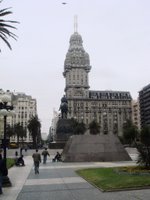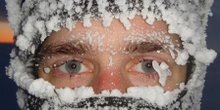Christmas in the Ice
And through the drifts the snowy clifts
Did send a dismal sheen:
Nor shapes of men nor beasts we ken--
The ice was all between.The ice was here, the ice was there,
The ice was all around:
It cracked and growled, and roared and howled,
Like noises in a swound!
Sea Ice Through a Porthole

The Rime of the Ancient Mariner, which has provided material for many of the blog entries, again captures the sense of desolation that being in the midst of the Antarctic can inspire, along with the noises that permeate through the ship as the hull grinds slowly through the heavy ice pack. As is clear possibly from this entry, the ship is not quite where it was expected to be; as I wrote the entry last time it appeared that we were less than twenty-four hours from our destination. Around eighty nautical miles out we encountered heavy ice that meant that Christmas was spent sitting conserving fuel, waiting for the conditions to improve. and ideally a 'lead' to appear to take us close to the site for the relief of Halley.
Ship's Course Through the Ice
Intended route is along the red line heading down the screen
The major problem has been second-year ice that has been broken about in storms across the winter, piled up on top of itself and then re-frozen providing a challenge for even this ship. These links provide a glossary to some of the terms used in respect of sea ice and some more information about how sea ice forms. Icebergs are different in that they are generally parts of glaciers or ice shelves that have broken off into the sea and are generally higher than five metres, hence these are avoided, though being freshwater they provide excellent ice cubes.
A Sunstar in the East
As a result it has been one of the most memorable Christmas celebrations I can remember, though for complicated reasons relating to work, Christmas lunch was on the 27th. Celebrations all kicked off with carol singing, though given the eerie twenty-four hour daylight, it does not quite have the same atmosphere at 10 o'clock at night. Any similarities to a Guantanamo Bay exercise yard were dispelled by the strong Welsh voices of Evans, Evans and Evans.
Just as we were getting used to the isolation, we were treated on Christmas day to a fly-past by one of the BAS Twin Otters working out of Halley. It had flown up to see whether they could identify any leads or easier sites for the ship's passage. It was co-piloted by the current Halley Doctor, Vicki, which at the moment is about as close as I have come to meeting her.
Twin Otter Fly-Past

It has been unusual not to be spending Christmas in a hospital and has made me appreciate the surroundings all the more. Lunch on the 27th was a quite spectacular blow-out where the cooks all showed off their abilities. Given that there are two ship's cooks along with summer (Issy) and wintering (Antony) chefs for Halley, there was quite an impressive array of food, all the more so given the remoteness of our location.
The View on Christmas Day
 Food generally on the ship can be a pitfall, it is not unknown for people to gain two stone during a short time on board. Ships still provision for the heavy labour that would have been involved not that long ago on merchant vessels; the fried breakfasts, snacks at smoko and excellent meals provide a trap for the undisciplined. All the more so given the furthest I may walk in a day is up four flights of stairs. (For the record and before I receive abusive emails- I have lost weight on the journey down!).
Food generally on the ship can be a pitfall, it is not unknown for people to gain two stone during a short time on board. Ships still provision for the heavy labour that would have been involved not that long ago on merchant vessels; the fried breakfasts, snacks at smoko and excellent meals provide a trap for the undisciplined. All the more so given the furthest I may walk in a day is up four flights of stairs. (For the record and before I receive abusive emails- I have lost weight on the journey down!).The Shackleton Alongside a Floe

With Christmas a rapidly fading memory, there has been time to get off the ship. Though sea ice can be treacherous (falling through ice into water at -2°C is not ideal), the captain managed to find some large floes of reliable thickness, for the ship to sit alongside while the we kept ourselves occupied with training sessions on the ice, including 'doo school to ensure we passed the proficiency tests prior to using the ubiquitous ski-doos at Halley.
'Doo School

My main transferable skill is teaching First Aid, so as a precursor to the winter DocSchool, the time has been filled with more training for those interested. Not surprisingly attempting to suture chickens back together has become a popular diversion.
Stevie B (Ship's Radio Officer) Performs Life Saving Surgery on a Frozen Chicken

Even though I have only been away about nine weeks now, it is easy to get blasé about the fantastic environment in which I am working. However, there can be few people who have the opportunity to learn the basics of field work, such as rope work and using ice axes, on the middle of an ice floe in the middle of nowhere with only Emperor penguins for company.
Emperor Penguins

They are so un-used to seeing other creatures on the ice and so inquisitive, though we are keen to ensure we do not disturb them by keeping a wide berth, they will waddle over or slide on their bellies to examine any activity, before disappearing off into the sea. None of these photos give an idea of their size, which is about three to four feet tall. The photo below demonstrates sea ice in the foreground with the cliffs, which rise to about 50 metres high, form part of the Stancomb-Wills ice stream, part of the Antarctic continent.
More Emperors


















































